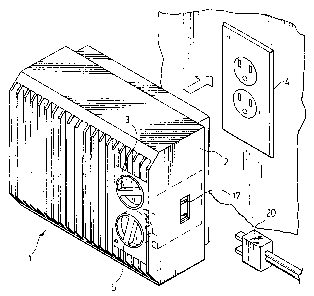Some of the information on this Web page has been provided by external sources. The Government of Canada is not responsible for the accuracy, reliability or currency of the information supplied by external sources. Users wishing to rely upon this information should consult directly with the source of the information. Content provided by external sources is not subject to official languages, privacy and accessibility requirements.
Any discrepancies in the text and image of the Claims and Abstract are due to differing posting times. Text of the Claims and Abstract are posted:
| (12) Patent: | (11) CA 2311011 |
|---|---|
| (54) English Title: | WALL MOUNTED HEATER FAN WITH ELECTRICAL OUTLET |
| (54) French Title: | VENTILATEUR D'APPAREIL DE CHAUFFAGE MURAL A PRISE DE COURANT |
| Status: | Term Expired - Post Grant Beyond Limit |
| (51) International Patent Classification (IPC): |
|
|---|---|
| (72) Inventors : |
|
| (73) Owners : |
|
| (71) Applicants : |
|
| (74) Agent: | DENNISON ASSOCIATES |
| (74) Associate agent: | |
| (45) Issued: | 2004-04-20 |
| (22) Filed Date: | 2000-06-08 |
| (41) Open to Public Inspection: | 2001-12-08 |
| Examination requested: | 2000-06-08 |
| Availability of licence: | N/A |
| Dedicated to the Public: | N/A |
| (25) Language of filing: | English |
| Patent Cooperation Treaty (PCT): | No |
|---|
| (30) Application Priority Data: | None |
|---|
An electrical appliance has a plug receptor to receive the plug of another appliance such that both appliances can draw power from a single electrical outlet. The appliance of the present invention is operable at different wattages and has a switch which is movable to different switch settings to determine the wattage at which the appliance is operating. When the switch is set such that the appliance operates at a high wattage, the plug receptor is blocked from access to the plug of the other appliance to prevent over loading of the electrical outlet.
Appareil électrique comprenant un récepteur de fiche destiné à recevoir la fiche d'un autre appareil de sorte que les deux appareils puissent obtenir de l'énergie d'une seule prise de courant. L'appareil de la présente invention peut fonctionner à différentes puissances et comprend un commutateur qui est mobile entre de différents réglages de commutateur afin de déterminer la puissance à laquelle l'appareil fonctionne. Lorsque le commutateur est réglé de sorte que l'appareil fonctionne à haute puissance, le récepteur de fiche est bloqué et ne peut accéder à la fiche de l'autre appareil pour empêcher une surcharge de la prise de courant.
Note: Claims are shown in the official language in which they were submitted.
Note: Descriptions are shown in the official language in which they were submitted.

2024-08-01:As part of the Next Generation Patents (NGP) transition, the Canadian Patents Database (CPD) now contains a more detailed Event History, which replicates the Event Log of our new back-office solution.
Please note that "Inactive:" events refers to events no longer in use in our new back-office solution.
For a clearer understanding of the status of the application/patent presented on this page, the site Disclaimer , as well as the definitions for Patent , Event History , Maintenance Fee and Payment History should be consulted.
| Description | Date |
|---|---|
| Inactive: COVID 19 - Deadline extended | 2020-08-06 |
| Inactive: COVID 19 - Deadline extended | 2020-07-16 |
| Inactive: COVID 19 - Deadline extended | 2020-07-02 |
| Inactive: COVID 19 - Reset Expiry Date of Patent to Original Date | 2020-06-16 |
| Inactive: COVID 19 - Deadline extended | 2020-06-10 |
| Inactive: COVID 19 - Deadline extended | 2020-06-10 |
| Inactive: Expired (new Act pat) | 2020-06-08 |
| Inactive: COVID 19 - Deadline extended | 2020-05-28 |
| Inactive: COVID 19 - Deadline extended | 2020-05-28 |
| Common Representative Appointed | 2019-10-30 |
| Common Representative Appointed | 2019-10-30 |
| Letter Sent | 2019-06-10 |
| Small Entity Declaration Determined Compliant | 2008-04-23 |
| Inactive: IPC from MCD | 2006-03-12 |
| Grant by Issuance | 2004-04-20 |
| Inactive: Cover page published | 2004-04-19 |
| Inactive: Final fee received | 2004-02-09 |
| Pre-grant | 2004-02-09 |
| Notice of Allowance is Issued | 2003-09-03 |
| Letter Sent | 2003-09-03 |
| Notice of Allowance is Issued | 2003-09-03 |
| Inactive: Approved for allowance (AFA) | 2003-08-21 |
| Application Published (Open to Public Inspection) | 2001-12-08 |
| Inactive: Cover page published | 2001-12-07 |
| Inactive: Correspondence - Formalities | 2000-09-13 |
| Inactive: First IPC assigned | 2000-08-04 |
| Inactive: IPC assigned | 2000-08-04 |
| Inactive: IPC assigned | 2000-08-04 |
| Inactive: IPC assigned | 2000-08-04 |
| Inactive: IPC assigned | 2000-08-03 |
| Inactive: Filing certificate - RFE (English) | 2000-07-20 |
| Filing Requirements Determined Compliant | 2000-07-20 |
| Application Received - Regular National | 2000-07-19 |
| All Requirements for Examination Determined Compliant | 2000-06-08 |
| Request for Examination Requirements Determined Compliant | 2000-06-08 |
There is no abandonment history.
The last payment was received on 2003-05-13
Note : If the full payment has not been received on or before the date indicated, a further fee may be required which may be one of the following
Please refer to the CIPO Patent Fees web page to see all current fee amounts.
Note: Records showing the ownership history in alphabetical order.
| Current Owners on Record |
|---|
| ART TATEISHI |
| Past Owners on Record |
|---|
| None |